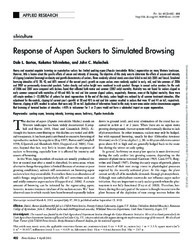| dc.contributor.author | Bartos, Dale L. | |
| dc.contributor.author | Tshireletso, Koketso | |
| dc.contributor.author | Malechek, John C. | |
| dc.date.accessioned | 2022-04-07T07:51:29Z | |
| dc.date.available | 2022-04-07T07:51:29Z | |
| dc.date.issued | 2014-04-02 | |
| dc.identifier.citation | Bartos, D. L., Tshireletso, K., & Malechek, J. C. (2014). Response of aspen suckers to simulated browsing. Forest Science, 60(2), 402-408. | en_US |
| dc.identifier.issn | 0015-749X | |
| dc.identifier.issn | 1938-3738 | |
| dc.identifier.uri | http://dx.doi.org/10.5849/forsci.13-505 | |
| dc.identifier.uri | https://hdl.handle.net/13049/419 | |
| dc.description | The article is published under CC BY-NC Licence. | en_US |
| dc.description.abstract | Heavy and repeated ungulate browsing on reproductive suckers has limited quaking aspen (Populus tremuloides Michx.) regeneration on many Western landscapes. However, little is known about the specific effects of season and intensity of browsing. The objectives of this study were to determine the effects of season and intensity of clipping (simulated browsing) on density and growth characteristics of suckers. Three randomly selected stands were clear-felled in mid-July 2005 and fenced. Simulated browsing intensities of 0, 20, 40, and 60% removal of the current year’s growth on aspen suckers were randomly applied in early, mid, and late summers of 2006 and 2007 on permanently demarcated quadrats. Sucker density and sucker height were monitored in each quadrat. Changes in annual sucker numbers for the ends of 2006 and 2007 were compared with declines found that reflected both winter and summer (2007 only) mortality. Mortality was not found for suckers clipped in early summer compared with mortalities of 48 and 46% for mid and late summer clipped suckers, respectively. However, even at the highest mortality, there were still ample numbers (~25,000/ha) of suckers for stand regeneration. At the end of the study, sucker height was reduced by all summer treatment intensities. After adjustment for the controls, clipping (of current year’s growth) at 20 and 40% in mid and late summer resulted in suckers that were 47 and 41 cm tall, respectively. However, clipping at 60% resulted in suckers that were only 20 cm tall. Application of information found in this study to new areas under similar circumstances suggests that browsing of terminal leaders at intensities < 40% in midsummer for 1 or 2 years would not have a substantial impact on aspen regeneration. | en_US |
| dc.language.iso | en | en_US |
| dc.publisher | Oxford Academic | en_US |
| dc.relation.ispartofseries | Forest Science;60(2), 402-408. | |
| dc.subject | Quaking aspe | en_US |
| dc.subject | Browsing intensity | en_US |
| dc.subject | Browsing season | en_US |
| dc.subject | Herbivory | en_US |
| dc.subject | Populus tremuloides | en_US |
| dc.title | Response of Aspen Suckers to Simulated Browsing. | en_US |
| dc.type | Article | en_US |

